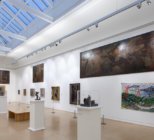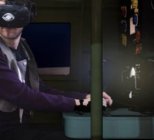This spring Arts Council England will launch its Digital Culture Network to support cultural organisations explore and utilise various digital technologies including content production, CRM, data analytics, E-commerce, productivity, SEO, social media and web design.
In late 2017 it launched the CreativeXR programme, which resulted in five projects selected last summer to share £350,000 supporting the development of VR and AR. A second round of applications to the CreativeXR programme concluded last month and the successful projects will be announced in the summer.
And this week the Arts Council and Nesta launch the latest round of the research study Digital Culture: How arts and cultural organisations in England use technology, its fifth incarnation.
More than 11,000 organisations from across the sector are invited to take part and the survey, will provide a detailed understanding of how technology is being used by the cultural sector, and how this has changed since the survey began in 2013.
Below we find out from Tonya Nelson, who last month became the Arts Council’s first Director of Arts Technology and Innovation, why digital technology is important and why it is crucial that a public body such as the Arts Council offers funding, expertise, guidance and research to digital innovation.
We also explore the development of one of last year’s successful CreativeXR projects: the RAF’s Dambusters VR, which opens next month, along with a case study from the Shire Hall Historic Courthouse Museum on its new AR artworks commemorating the Tolpuddle Martyrs. We also feature an Ask the Expert Q&A from Concord on innovations in lighting including their work on Leeds Art Gallery, which was recently redeveloped.
Q&A with Tonya Nelson, Arts Council’s Director of Arts Technology and Innovation
Tonya Nelson joined the Arts Council from University College London – home of the Petrie Museum of Egyptian Archaeology – where she was Director of Museums and Cultural Programmes, and will lead the Arts Council’s policy work supporting the cultural sector to adopt new technologies. She co-authored the Culture is Digital policy paper for DCMS, which was published in March 2018, and has led a number of projects exploring the application of 3D imaging, augmented reality and gesture recognition technologies in museums.
What does your new role as Arts Council’s director of arts, technology and innovation involve and how will your past experience guide you?
My role will involve working with a team of people at the Arts Council tasked with supporting arts and culture organisations in responding to the opportunities and challenges presented by new digital technologies. I will focus on helping organisations develop new types of content and audience experiences using technologies such as VR and AR. I worked on range of R&D projects in the area of 3D imaging, immersive tech, gesture recognition and gaming while working with the museums at UCL and have an understanding of the challenges faced by cultural sector leaders in determining how much time, money and resource to allocate to responding to the latest technology and digital trends. This will frame my thinking about how the Arts Council can help to the support the sector. Furthermore, As one of the authors of the DCMS Culture is Digital report, I will also help the Arts Council with implementing the report‘s recommendations. I feel lucky to be in the position to see policy become a reality.
How important is it that public bodies such as Arts Council help support and help cultural organisations push the boundaries of innovation and technology with programmes such as CreativeXR and how will this be continued in the future?
The role the Arts Council and other public bodies play is really important as the ability of arts and culture organisations to respond to changes in the digital landscape will have a major impact on their relevance and long term sustainability. As a result, government funding to support research into immersive technologies has significantly increased over the last 5-10 years. Programmes like CreativeXR not only provide seed funding for immersive projects but also provide the technical expertise, equipment and space for experimentation. The Arts Council as well as other agencies and organisations that support the arts and tech sectors will continue to help the cultural sector create capacity-building partnerships, build and embed new skills, and develop new business models.
When we talk about technology and innovation in museums and cultural organisations what do we mean – are there any good examples that spring to mind?
When we talk about technology and innovation in museums and other parts of the heritage sector we mean everything. It is about organisations’ mission and objectives and understanding how new technologies can be used to achieve them. This can mean using immersive technologies to enable audiences to engage with content in exhibitions or using audience data more effectively to make business decisions. I could point out examples, but the point really is that organisations have to decide how to integrate technology into their organisations in ways that suit their circumstances. The Arts Council is in the process of developing the Digital Maturity Index referenced in the Culture is Digital Report. This tool will allow organisations to assess themselves based on their individual organisational strategies.
As the co-author of Culture is Digital, in what ways would you say the cultural sector’s understanding of new technologies has improved over the past few years?
According to the most recent Digital Culture Survey commissioned by NESTA and the Arts Council, there are areas in which it appears the cultural sector is gaining real confidence, particularly in using digital technologies to disseminate content and offer access to resources and expertise. I think improvement can be most seen in the way organisations are approaching digital projects: I get the sense that organisations are conducting small scale experiments and developing new products and content through an iterative process as opposed to investing in a big untested concept or idea. Using iterative processes not only reduces project-based risk, but is key to creating a learning organisation that is innovative, dynamic and sustainable.
What is the future potential for technology in museums and the main reasons for museums and cultural organisations to embrace technological and digital innovations?
From a personal perspective, I am excited about the prospect of using technologies to provide more context for objects. The opportunity to see an ancient Egyptian artefact and then be transported into a virtual space where you can see where it was found at an archaeological site and then see it in use in daily life in an ancient Egyptian household, for example, would be quite an experience. I also like the idea of using virtual spaces to aid collaborative exhibition design and development. Audience studies show that digitally native millennials and future generations will expect experiences that are personalised and interactive. Traditional passive museum experiences won’t cut it. So there is an imperative for museums to embrace digital technology in order to remain relevant. There is also the fundamental question of the nature of collecting in a digital world. As we increasingly live our lives online, it will be interesting to see how museums begin to collect, provenance, and display ‘digital’ artefacts. I know a number of museums here and abroad are starting to think about this issue, but it will become bigger issue new digital technologies start to embed themselves in daily life.
What are some of the challenges that these organisations face when trying to innovate and include technology into their offer and how can these be overcome?
It can all feel very overwhelming in terms of time, money and staff resources. That’s why it is important to understand how digital technology relates to your organisation’s strategy and to focus on those areas where it will have the most impact. The key is to start small and break big projects into a series of small ones. If your organisation’s ambition is to be more responsive to audiences, before investing in an all singing and dancing CRM system, you may consider using free and readily available tools or tapping into existing systems such as Audience Agency’s Audience Finder system.
In the past three years the use of augmented and virtual reality has become more common (through better partnerships with creative tech companies) in museum exhibitions – do you see this having positive effects on their offer and what other technologies do you see being beneficial?
Yes. I do see the use of augmented and virtual reality in museums getting better and better. When I was working with the technology at the Petrie Museum five years ago, we thought hard about how to ensure the experiences we were producing were not just novelties. We wanted to use these technologies to offer real insight and to make history come to life. The ability to present content in new and different ways can only be positive as it will make museums more accessible to a wider range of audiences. I am interested in the evolution of haptic technologies in conjunction with 3D digital collections. Giving audiences the opportunity not only to see objects in their totality but feel their weight and texture is an exciting new opportunity.
Last year the DCMS set up a Government Office for Artificial Intelligence. Is AI on your agenda and if so what potential does this technology have for museums?
AI is certainly on the agenda at the Arts Council and I am keen to explore the impact of AI across the cultural sector. In terms of museums, machine learning could speed the pace of cataloguing, offer JIT answers to visitors’ questions via chatbots, and generate predictive models for audience behaviours that could mitigate risk and make museum planning more effective.
Previous In Focus Features
January 2019
Tendering in museums: a fundamental element to successful capital projects
November 2018
Digital Museum Guides: enhancing modern-day visits with audio guides, apps and AR
October 2018
Emergency planning in museums – what you should be doing
September 2018
Conservation and collection care: Using X-rays to preserve the Mary Rose Museum’s Cannonballs
August 2018
One Collection: The future of the Science Museum Group’s storage and archive facilities
June 2018
Digitising collections: how technology is speeding up the process of big data
April 2018
Exhibition design: creating theatre in our cultural spaces
March 2018
Understanding your Visitors – Defining and explaining the visitor offer with Colin Mulberg Consulting
February 2018
Touring Exhibitions – Dippy on Tour: transporting Britain’s most famous dinosaur
January 2018
Technology in Museums – introducing new ways to see the cultural world
December 2017
Museum lighting – the dark art of brightening up our cultural spaces
November 2017
Education in Museums: creating a learning culture through participation and outreach












